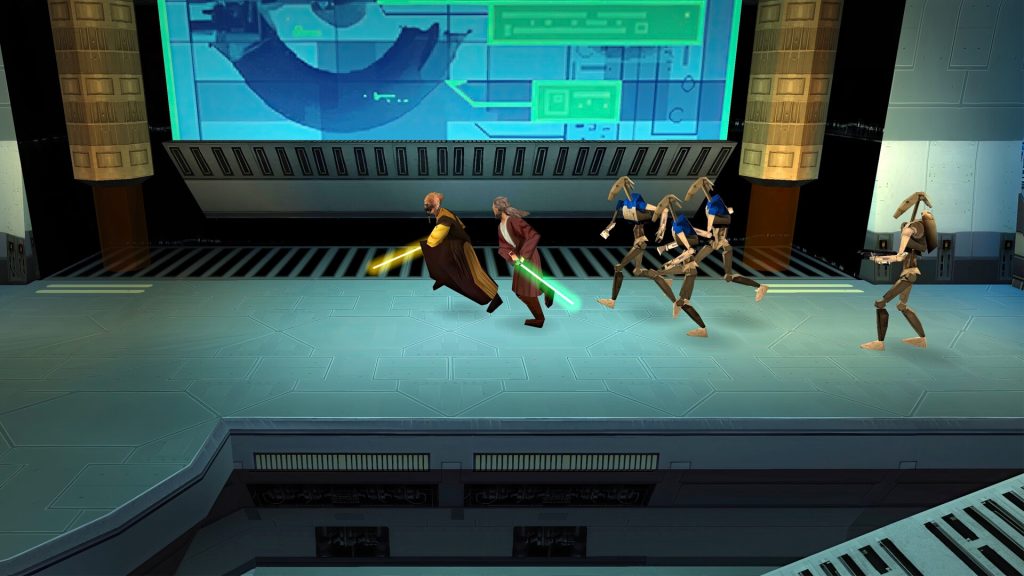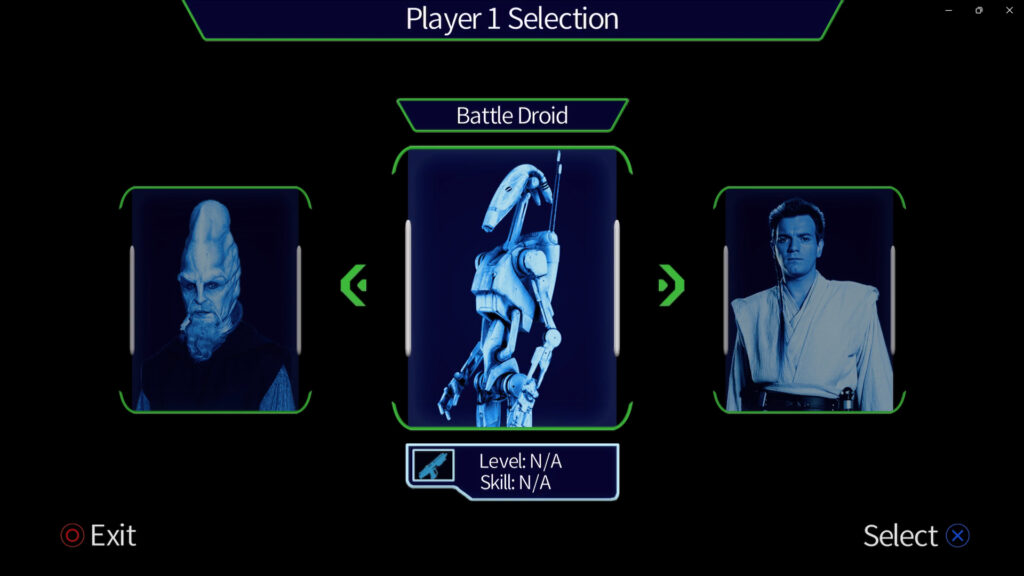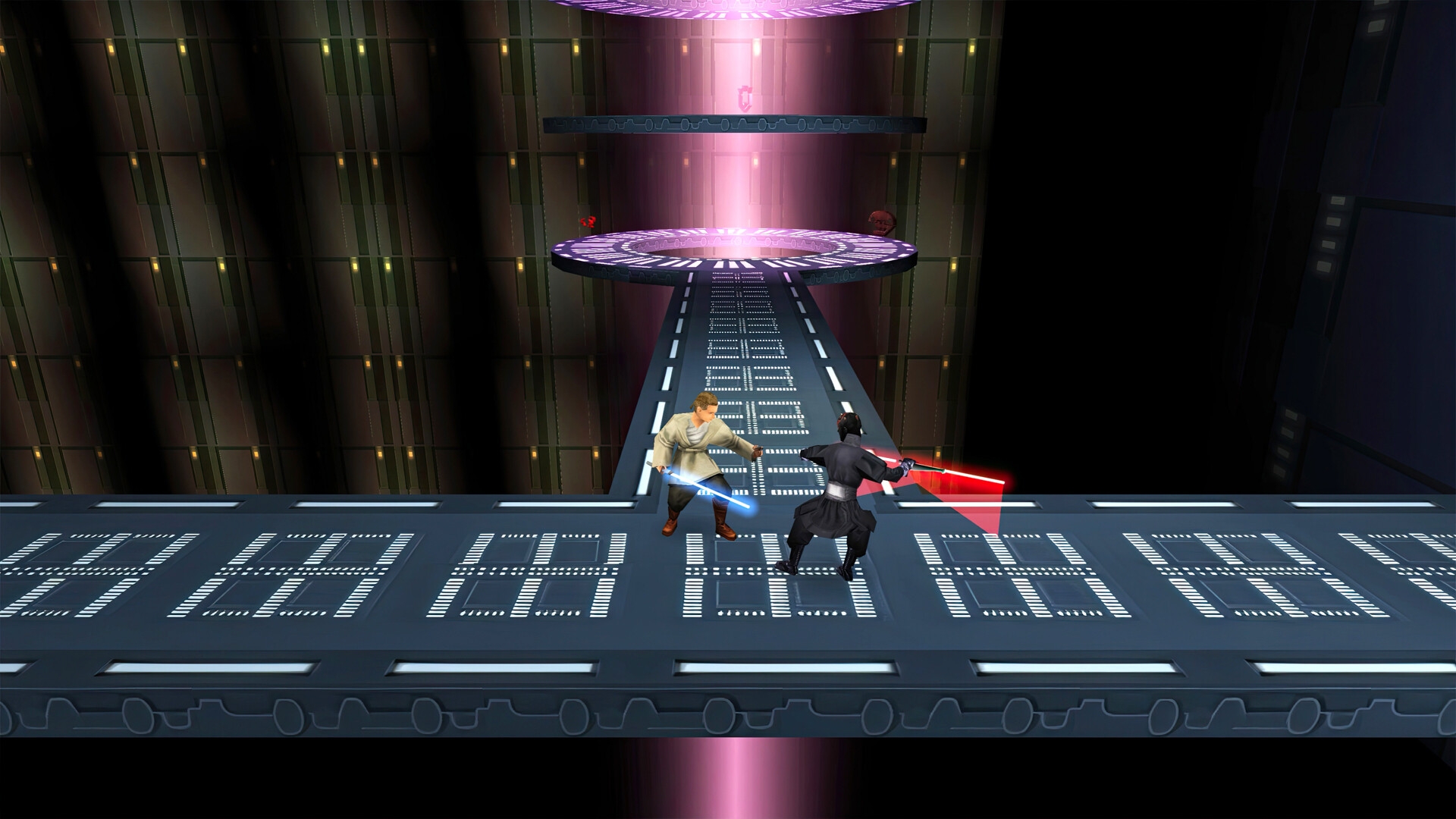STAR WARS: Episode I: Jedi Power Battles Remastered Review – A Middling Remaster
The string of classic Star Wars remasters continues with Star Wars Episode I: Jedi Power Battles. The original early 2000s PlayStation game was somewhat ahead its time with a pseudo-3D graphical perspective and combo-based lightsaber combat. The interesting blend of action-platforming and the beat-em-up genre diversified the Star Wars video game catalogue quite a bit back then. Thinking of Jedi Power Battles within the framework of a Super Star Wars successor makes me want to love the game more than I would otherwise. This really is a kind of follow-up to those classic 90s Super Nintendo games, though it misses the mark in several notable ways.
But before we get to its misfires, let’s first see what Aspyr has improved and added to this remaster. While Jedi Power Battles originally released on the PlayStation, its Dreamcast version is considered superior; this remaster is based on the Dreamcast version’s source code. Aspyr has combined elements of both versions, notably preserving the UI elements from the PlayStation version as well as several graphical details in the levels.

“Jedi also have the advantage of deflecting blaster shots, something that is really satisfying to pull off due to the tight timing required.”
The graphics have improved resolution and razor-sharp texture, as is expected in any remaster, but the lack of a classic graphic toggle is somewhat unfortunate. Also, unfortunate is the lack of save states coupled with a single save file per account. As far as brand-new content, we get 13 new playable characters in addition to the original Dreamcast roster, adding to 22 characters total. Lightsaber colors can now be toggled to represent their ‘canon’ version, which is great for fans of Mace Windu and his purple saber.
Speaking of lightsabers, this game does a fairly good job putting you in the shoes of a jedi (or sith) with the simple yet satisfying combo system. Each jedi has three distinct attacks that can be combined with each other so long as you unlock said combo. Some players would prefer if all combos were available from the start, but I respect the sense of progression that unlocking them adds to the game. You also get an upgrade to either health or force power each time you complete a stage with a character.
Jedi are further differentiated by their unique Force abilities. While some attacks can feel similar across the characters, their force abilities change the playstyle up in a more noticeable way. Obi-Wan’s lightning-speed Force Saber Dash cuts groups of droids in one swift motion – making it great for aggressive AOE style of play. Meanwhile, Ki-Adi-Mundi employs mind control which stuns enemies for a brief period, representing his methodical and patient demeanor.
Jedi also have the advantage of deflecting blaster shots, something that is really satisfying to pull off due to the tight timing required. My only real issue with the progression system in Jedi Power Battles is that each account only gets one total save for all progression within the game. This means that if you select ‘new game’ and confirm, it’ll completely overwrite all progress with your save file. This is something that I mistakenly did after leveling up Qui-Gon three times; it’s just far too easy to overwrite and erase all your progress by accident. The single save file limitation is certainly something the remaster could’ve remedied.
But hey, at least all the secret characters from the Dreamcast version are available right from the beginning in this remaster, right? Yeah, that is nice, especially since I enjoy Ki-Adi-Mundi’s mind tricks, however a majority of the secret characters you unlock later don’t feel as varied and worthwhile as the jedi do. The droids and Tusken Raider have similar blaster and melee attacks, while others like the Droideka thankfully feature unique abilities. It’s also a cool novelty to play as Jar-Jar and hear his infamous howling while falling off a Coruscant skyscraper. Besides different attacks, each character has their own attack power, speed, and health, making them feel distinct enough from one another.

“All the secret characters from the Dreamcast version are available right from the beginning”
Unlocking all those secret characters can be a bit of a pain, though, considering how janky and rough the controls and level design are. Oh, no, I’m not speaking of the classic control scheme, that is borderline unplayable (even if I appreciate its inclusion). The modernized controls still feel rigid and unresponsive. The perfect example of this is the infuriating dash skid that every character does when stopping after a run. The skid animation locks out the ability to jump or attack until it is finished, something that resulted in many early game deaths. Of course, one can just get used to it after a while, but it exemplifies an archaic rigidness in movement that is difficult to overlook considering the amount of precision platforming the game demands of the player.
To the game’s credit, each of the 10 levels vary in their platforming and enemy challenges, and all can be played right from the start. One stage you’re atop the highest skyscrapers of Coruscant where any misstep spells instant death, and the next you’re simply shimmying over rotundas and balconies. Driving around an AAT was such a power trip back when this came out, and I’ve got to say, it still feels great today even though it’s brief. Running over droids and blowing up enemy AATs is a blast thanks to the great swivel gun and vehicle movement, if only regular character movement was as fun. If there’s one thing Phantom Menace haters can agree on, it’s the well-realized setting and environments, and Jedi Power Battles does its best to translate this to its action-platformer beat-em-up DNA.
But even as an unapologetic Episode 1 fan who can’t help but grin while journeying through the film’s scenarios and locations, I just couldn’t enjoy the experience as much as I wanted to. For one, the lack of a discernable character shadow while jumping makes it difficult to judge distance. Characters also descend like a brick, rendering last-second adjustments next to impossible.
Oh, and there’s fall damage on top of that. While the game mostly sticks to a side-scrolling perspective, it often requires three-dimensional movement within that space. This would be fine if many ledges and balconies weren’t gated off by invisible walls. The game doesn’t do a good job telling the player what area is off-limits or can’t be interacted with, causing many invisible wall deaths and the like. Helping to ease the platforming irritants are the remaster’s improvements to jump height and distance. It’s nice that Aspyr has tried to smooth out the experience where they could, but only so much can be done to elevate the core controls and level design.
An example of rough level design is the counter-intuitive guidance of where to go next. Take the changing camera perspective when entering the bridge area of the Trade Federation Ship. The level has been progressing from left to right up until that point, with no indication you’re suddenly expected to go left after a complete perspective change. I can’t be the only one who wasted time and lives continuing on to the right only to loop back to previous zones fighting respawned droids over and over. In a similar vein, scripted events sometimes occur during gameplay, causing changes to the stage such as an exploding platform or basted entryway.
Coruscant has one such event while balancing atop a car. Despite my best attempts to avoid a plumet to my death, the car platform I’m on gets hit by another vehicle out of absolutely nowhere. These instances are pure trial and error and next to impossible to prepare for if you haven’t played before, resulting in an annoying trial and error experience.
Some other annoyances that compound the rough level design are unskippable scenes, limited lives per level, and the occasional poorly paced checkpoint. The ability to use save states anywhere in a level could’ve helped alleviate the irritating design elements a bit, but I guess if Mega Man X Legacy Collection didn’t add that, I shouldn’t expect Aspyr to add it for Jedi Power Battles.

“Jedi Power Battles can be a fun time if you’re a fan of action-platforming beat-em-ups or have a co-op partner to play with.”
Finally, I have to mention the boss fights. Minibosses and level bosses comprise the real difficulty cliff in Jedi Power Battles. There’s typically a med pack or two in any boss arena to aid in your stun-locking struggle. The two flamethrower droids really gave me headache with their incessant stun-locking and obscure hurt box. It’s difficult to judge the distance between the flames and your character and the imprecise control movement doesn’t help matters. Oh, and that Tatooine escort level with Anakin? Oof, the close rubber banding that Anakin has with your character combined with friendly fire makes for a dreadful combo in escort mission design.
I could go on about little issues that I’ve had here and there, but you probably get the idea. While Aspyr did a pretty good job eliminating bugs and glitches that plagued the original game, Jedi Power Battles still suffers from its intrinsic level design failures. Jedi Power Battles can be a fun time if you’re a fan of action-platforming beat-em-ups or have a co-op partner to play with, but its irritants outweigh the nostalgic charm and novelty pretty fast.
This game was reviewed on the PlayStation 5.


Comments are closed.